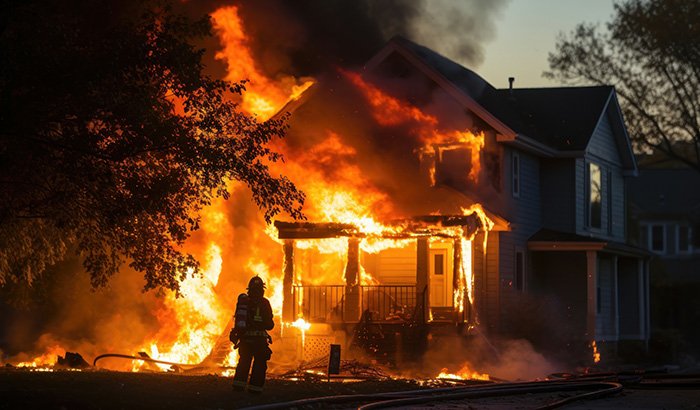A fire Damage in a commercial property can be devastating, leading to structural damage, loss of inventory, and significant business interruptions. In the aftermath, filing a fire damage claim is a critical step toward recovery, but the process can be complex and time-consuming. Understanding the steps involved ensures business owners can efficiently document losses, work with insurance adjusters, and receive fair compensation. We will explore the essential stages of the commercial fire damage claim process, from immediate actions after the fire to final claim resolution, helping business owners regain stability and resume operations effectively.
Immediate Steps Following a Commercial Fire
After a commercial fire, the first step is ensuring safety and securing the property to prevent further damage. Once the fire department has extinguished the flames and confirmed that it is safe to enter, property owners should assess the extent of the destruction. However, before making any assumptions about the damage, it is crucial to document everything. Taking photos and videos of affected areas, equipment, inventory, and structural damage will provide a strong foundation for the claim. Additionally, keeping a record of any emergency repairs, such as boarding up windows or covering damaged roofs, is necessary, as these costs may be reimbursed.
After documentation, business owners should notify their insurance company immediately. Most policies require prompt reporting of fire damage to ensure a smooth claims process. Insurance providers typically send an adjuster to evaluate the damage, so it is beneficial to have all necessary records readily available. At this stage, it is also helpful to review the insurance policy to understand coverage limits, exclusions, and any clauses related to fire damage. Business interruption coverage, if included, can help compensate for lost income while repairs are underway. These initial steps are crucial in ensuring a structured approach to filing a fire damage claim and minimizing delays in the recovery process.
Understanding Fire Damage Documentation Requirements
Proper documentation is the backbone of a successful fire damage claim. Insurance companies require detailed records to assess the extent of the loss and determine appropriate compensation. One of the most important components is an inventory list, which should include descriptions of damaged goods, their estimated value, and proof of purchase when possible. This helps insurers calculate replacement or repair costs. If financial records, contracts, or important business documents were lost in the fire, efforts should be made to retrieve electronic copies or alternative proof.
Photographic evidence plays a crucial role in substantiating claims. High-resolution images and videos should be taken from multiple angles to highlight the full scope of the damage. These visuals should be accompanied by written reports detailing the condition of different areas before and after the fire. Additionally, obtaining statements from employees, customers, or nearby businesses who witnessed the incident can strengthen the claim. Fire department reports, which provide an official event account, should also be included as supporting evidence.
Beyond damage assessment, business owners should track any expenses incurred due to the fire. This includes repair costs, temporary relocation expenses, and losses related to business interruption. Keeping receipts and invoices ensures transparency and helps justify the claim amount. The more comprehensive the documentation, the smoother the process, reducing the chances of disputes or insurer claim denials.
The Role of the Insurance Adjuster in Evaluating the Claim
Once a fire damage claim is filed, the insurance company assigns an adjuster to assess the damage and determine the appropriate payout. The adjuster’s role is to inspect the property, review documentation, and calculate the costs necessary for repairs and replacements. Business owners should be prepared for multiple visits and detailed questioning as the adjuster works through their evaluation.
During the assessment, it is beneficial to accompany the adjuster in thoroughly examining all damages. Some damages, especially those related to smoke and water infiltration, may not be immediately visible but can cause long-term issues if left unaddressed. Pointing out hidden damages and providing supporting evidence can help ensure they are included in the final report. Additionally, business owners should compare the adjuster’s findings with their documentation to verify accuracy.
Business owners can challenge the evaluation if the insurance company’s estimate differs from the repair costs. Seeking independent assessments from contractors or fire damage restoration services can provide a second opinion on repair expenses. Maintaining open communication with the adjuster while advocating for a fair settlement is key to ensuring the claim covers all necessary expenses.
Negotiating a Fair Settlement and Resolving Disputes
Once the adjuster completes their assessment, the insurance company presents a settlement offer based on their calculations. Sometimes, the initial offer may not fully cover the damages or losses suffered. Business owners should carefully review the proposed settlement and compare it with their estimates to determine if the amount is reasonable. If there are discrepancies, negotiations may be necessary to reach a fair agreement.
Insurance companies often rely on depreciation values to reduce payouts, which can result in lower compensation than expected. Understanding how depreciation is calculated and whether the policy includes replacement cost coverage or actual cash value (ACV) is essential. Replacement cost policies cover the full expense of replacing damaged items, while ACV policies factor in depreciation, leading to lower payouts. If the settlement does not align with policy terms, business owners can present counterarguments supported by repair estimates, receipts, and third-party evaluations.
While fires can disrupt operations and cause financial setbacks, a well-managed claim can aid in a successful recovery. Business owners who understand policy terms, track expenses, and seek fair compensation can rebuild confidently. As the restoration process concludes, focusing on fire prevention strategies and reviewing insurance coverage ensures better preparedness for the future. Through resilience and strategic planning, businesses can overcome the challenges of fire damage and emerge stronger than before.



